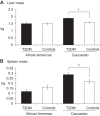Skeletal muscle and organ masses differ in overweight adults with type 2 diabetes
- PMID: 24947030
- PMCID: PMC4137236
- DOI: 10.1152/japplphysiol.01095.2013
Skeletal muscle and organ masses differ in overweight adults with type 2 diabetes
Abstract
Whether lean body mass (LBM) composition, especially skeletal muscle and abdominal organs, differs in adults with type 2 diabetes (T2DM) compared with nondiabetic healthy controls has not been investigated. A subset of African-American and Caucasian participants with T2DM from the Look AHEAD (Action for Health in Diabetes) trial had body composition assessed and compared with a sample of healthy controls. Skeletal muscle mass (SMM), liver, kidneys, and spleen mass were quantified using a contiguous slice magnetic resonance imaging (MRI) protocol. Cardiac mass was quantified by either a cardiac gated MRI protocol or by echocardiography. MRI volumes were converted to mass using assumed densities. Dual-energy X-ray absorptiometry assessed LBM. Using general linear models adjusted for height, weight, sex, age, race, and interactions of diabetes status with race or sex, persons with T2DM (n = 95) had less LBM (49.7 vs. 51.6 kg) and SMM (24.1 vs. 25.4 kg) and larger kidneys (0.40 vs. 0.36 kg) than controls (n = 76) (all P < 0.01). Caucasians with T2DM had larger livers (1.90 vs. 1.60 kg, P < 0.0001) and spleens (0.29 vs. 0.22 kg, P < 0.01), and T2DM men had less cardiac mass than controls (0.25 vs. 0.30 kg, P < 0.001). In this sample, T2DM is characterized by less relative skeletal muscle and cardiac mass in conjunction with larger kidneys, liver, and spleen. Further investigation is needed to establish the causes and metabolic consequences of these race- and sex-specific organ mass differences in T2DM.
Keywords: African American; Caucasian; kidneys; liver; magnetic resonance imaging; spleen.
Copyright © 2014 the American Physiological Society.
Figures



References
-
- Albright A, Franz M, Hornsby G, Kriska A, Marrero D, Ullrich I, Verity LS. American College of Sports Medicine position stand. Exercise and type 2 diabetes. Med Sci Sports Exerc 32: 1345–1360, 2000 - PubMed
-
- Banerji MA, Chaiken RL, Gordon D, Kral JG, Lebovitz HE. Does intra-abdominal adipose tissue in black men determine whether NIDDM is insulin-resistant or insulin-sensitive? Diabetes 44: 141–146, 1995 - PubMed
-
- Bitz C, Toubro S, Larsen TM, Harder H, Rennie KL, Jebb SA, Astrup A. Increased 24-h energy expenditure in type 2 diabetes. Diabetes Care 27: 2416–2421, 2004 - PubMed
-
- Bogardus C, Taskinen MR, Zawadzki J, Lillioja S, Mott D, Howard BV. Increased resting metabolic rates in obese subjects with non-insulin-dependent diabetes mellitus and the effect of sulfonylurea therapy. Diabetes 35: 1–5, 1986 - PubMed
Publication types
MeSH terms
Grants and funding
LinkOut - more resources
Full Text Sources
Other Literature Sources
Medical

